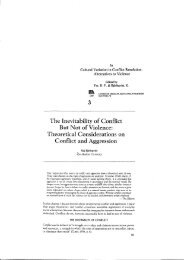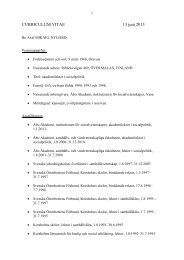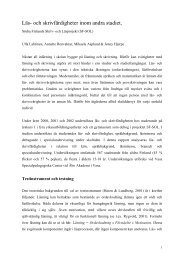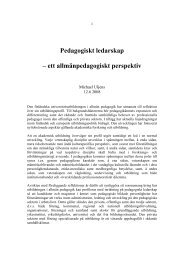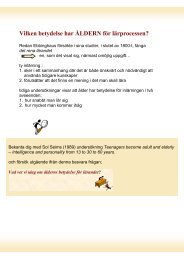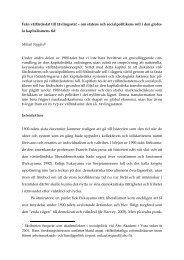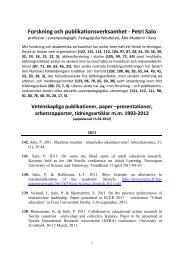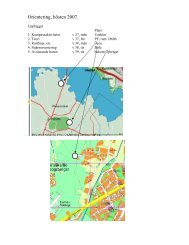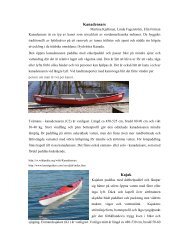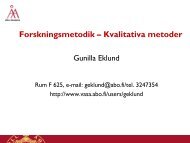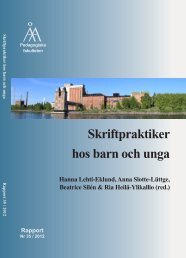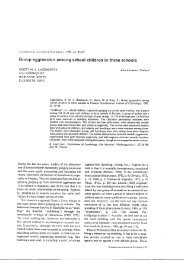Parties, Candidates and Citizens On-Line - Åbo Akademi
Parties, Candidates and Citizens On-Line - Åbo Akademi
Parties, Candidates and Citizens On-Line - Åbo Akademi
You also want an ePaper? Increase the reach of your titles
YUMPU automatically turns print PDFs into web optimized ePapers that Google loves.
Nousiainen 1998, 55-59; Sundberg 1996, 209-210). Obviously, as elsewhere, the<br />
boundaries between the Finnish parties’ target voters have become more fluid over time<br />
(cf. Maarek 1995; Swanson & Mancini 1996). Scholars have nonetheless argued that the<br />
role of the old ‘class-parties’ can be traced in the new voter bases of the Finnish parties<br />
(Sundberg 1996, 212-3; Zilliacus 2001, 32).<br />
Concerning the four parties included in cluster II – the SDP, SPP, Christian<br />
Democrats <strong>and</strong> Alternative People – common denominators are also hard to find in the<br />
theoretical backdrop. Regarding the type of voters, one could tentatively argue that none<br />
of these parties have potential voters clearly resembling the socio-economic traits of the<br />
typical internet user (cf. Norris 2001b, 78; Sundberg 1996, 118, 209-210). Even so, such<br />
parties were also found in the first cluster, which indicates that the type of voters did not<br />
discriminate between the two clusters. Regarding party goals, organization type <strong>and</strong> size,<br />
these four parties represent the whole spectrum. The SDP is primarily a vote-maximizing<br />
party but has a strong office-seeking agenda as well. The SPP is often part of the Finnish<br />
government, possibly partly due to an emphasis on office-maximization. However, in<br />
representing the Swedish speaking minority population, the party is mainly a policy-driven<br />
party (Nousiainen 1998, 34-35; Sundberg 1996, 16). Similarly, the Alternative People<br />
focuses specifically on anti-EU policy while the Christian Democrats mainly promotes<br />
Christian values (Nousiainen 1998, 58). The Alternative People is hard to assess in terms<br />
of organizational type. Nonetheless, the remaining parties display a mix of organization<br />
types. The SDP has a mass-party background typical for socialist parties in western<br />
countries but has over time evolved into a cartel party (cf. Löfgren 2001, 29; Nousiainen<br />
1998, 34; Sundberg 1996, 16). The SPP is also often part of the governmental ‘cartel’.<br />
Historically, though, the party has a cadre-like history as it sprang from several smaller<br />
fractions coming together under one central organization (cf. Katz & Mair 1995, 19-20;<br />
Nousiainen 1998, 34-35, 59-60; Sundberg 1996, 18). The Christian Democrats have a<br />
hierarchical organization focused on strong leadership (cf. Zilliacus 2001, 39; Sundberg<br />
1996, 75), which is one trait typical for catch-all parties (cf. Katz & Mair 1995, 7-8). In<br />
terms of size, the SDP is one of the ‘big three’ in Finnish politics, the SPP <strong>and</strong> Christian<br />
Democrats are minor parliamentary parties <strong>and</strong> the Alternative People is a fringe party.<br />
In sum, with regard to the two party clusters found in the party questionnaire,<br />
none of the four party traits seem to have any noticeable influence on the Finnish parties’<br />
opinions concerning the importance <strong>and</strong> use of their websites. Nonetheless, certain<br />
findings for individual parties – for example the Green League scoring highly on<br />
engagement or the fringe parties being more positive towards the website than the major<br />
parties – may still seem theoretically reasonable. In general, though, no theoretic<br />
circumstance appears applicable in explaining the Finnish parties’ ‘inside view’ on their<br />
websites.<br />
98



